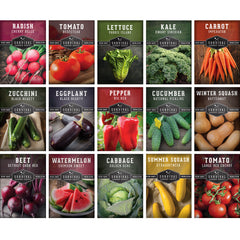Peppers and tomatoes are perennial plants in the right environment; however, in most of the United States, the weather becomes inhospitable to these heat-loving plants, so they are usually grown as annuals. It is possible to overwinter peppers and tomatoes indoors instead of starting fresh from seed every year, which provides several benefits and is fairly easy.
Why Overwinter Peppers and Tomatoes
There are several reasons for overwintering pepper and tomato plants. It allows for quicker growth in spring, leading to faster production and larger yields. It also preserves the genetics of plants that have adapted to your local environment or produced particularly well. It is even possible to produce tomatoes all winter long.
How to Overwinter Pepper Plants Indoors
Peppers will show signs of stress and start dropping leaves when overnight temperatures reach about 40°F. This is the time to begin the overwintering process. As with other plants that you bring indoors, the first step is to ensure your pepper plants are free of pests and disease. Because you’ll be trying to keep the peppers mostly dormant through the winter, do this by removing any remaining peppers and all of the leaves. Then prune back the plant leaving the main stem and optionally a few branches with one or two leaf nodes. This may seem extreme, but as long as there is a stem and healthy roots, the plant is still alive.

After this, you can dig up your pepper plant or remove it from its original container. Loosen the roots with your hands to break up and remove the soil. Rinse roots with a hose to remove as much soil as possible. This is another step toward eliminating any remaining pests. If you choose, you can dip the root ball in a bath of water and insecticidal soap.
Now you can repot your peppers in fresh, sterile soil in a container that comfortably holds the root ball of the plant. First pack in about an inch or two of moistened soil for the root ball to rest on, then hold the plant upright with the base of the stem about one inch below the top of the container, fill it with soil, and pack down lightly. You can add some sand or diatomaceous earth to the top of the soil to prevent any remaining insects from crawling up the stems.
Water your plant and place it in a cool place. The ideal overwintering temperature for peppers is between 55°F and 65°F, so a garage or basement should work. Just be sure that the temperature never gets too cold, which could stress or freeze the plants. The plants will not be growing through the winter, so they do not need a lot of light or water and no fertilizer. As spring approaches, harden off your plants as you would regular seedlings. Move back outside after overnight temperatures are consistently over 65°F.
How to Overwinter Tomato Plants Indoors
There are several ways to keep tomato plants alive through the winter. If you have a greenhouse and grow indeterminate plants, you can continue to have fresh tomatoes all winter long. Given plenty of light, tomatoes will also grow well indoors, although you might want to consider growing a dwarf variety like Tiny Tim that will not take up a lot of space.

One of the easiest ways to overwinter tomato plants is to grow new plants from cuttings. Before the first frost is the best time to take cuttings. The best cuttings come from the “sucker” that grows between the stem and leaf branches, as long as it is about 6 inches long. Trim the sucker, remove all but the last 2 leaves, and place it in a jar of water. Within a couple of weeks, you should see roots on the cutting. You can then transplant the plantlet into fresh potting soil.
Keep your new plants in a sunny window or under grow lights. As your plants grow, you can even take additional cuttings from them and expand your propagation. Treat your young plants just like you would sprouts from seed. Increase the pot size as needed and harden it off after the danger of frost before transplanting it into your garden.
Get a Head Start on the Next Growing Season
Taking the time to properly overwinter your peppers and tomatoes will give you a big head start in the spring. You will already have plants well adapted to your locale and known good performers. Starting with established plants will allow earlier fruit production and a longer growing season leading to higher yields. Take advantage of the opportunity these perennial vegetables provide and enjoy your harvest!
























